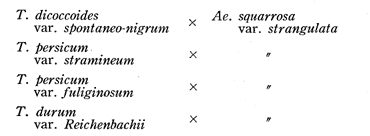H. KIHARA, K. YAMASHITA, M. TANAKA and J. TABUSHI
National Institute of Genetics, Misima and Kyoto University, Kyoto, Japan
Aegilops squarrosa var. strangulata was collected in Iran by the senior author, the leader of the Kyoto University Scientific Expedition to the Karakoram and Hindukush in 1955. According to Hiratsuka's unpublished data, this variety is resistant to Puccinia triticina, while all the strains of Ae. squarrosa var. typica are susceptible. Consequently, we have synthesized new amphidiploids from the hybrids, Emmer wheats x Ae. squarrosa var. strangulata, as listed below. They were produced by the union of unreduced gametes.

The percentage of normal pollen grains and seed-fertility of F1 hybrids (3x) are shown in Table 1. 21 univalents were observed in most of the PMC's in 3x hybrids, except T. dicoccoides var. spontaneo-nigrum x Ae. squarrosa var. strangulata and abundant normal pollen grains (up to 93%) due to restitution were produced. Their seed-fertility was comparatively high (up to 47.9%). The fertility was higher in the late head than in the early one (Table 2). For instance seed-fertility of one individual was 14.7% in the early head and 47.7% in the late one.
The hybrid vigor was expressed strongly in most of those 3x hybrid plants, while T. durum x Ae. squarrosa var. strangulata was semi-dwarf and weak. Investigations concerning the resistance of the synthesized amphidiploids to P. triticina are in progress.
Errata
In a paper "Linkage analysis by RT-method (WIS No. 5, p. 3)" by K. Yamashita, an important typographical error was overlooked, which is corrected here as follows:

In a paper "B chromosome in Aegilops mutica Boiss." published in WIS No. 5 by A. Mochizuki, 0 configuration (line 6 from the bottom, page 10) should read 0-configuration, which is a frying pan form of a trivalent.
(A. M.)